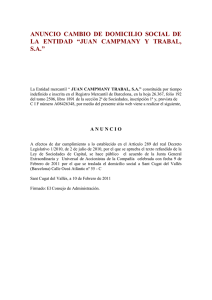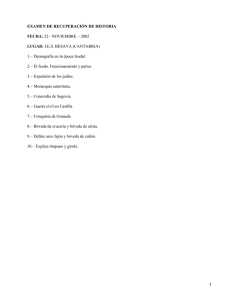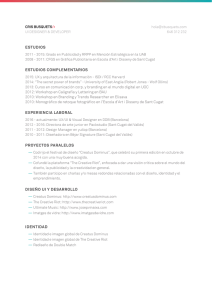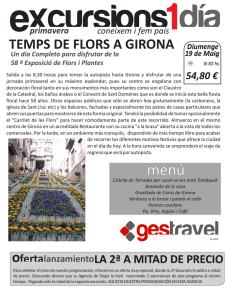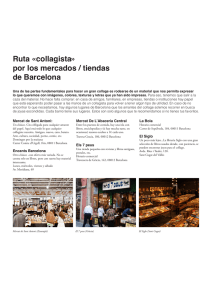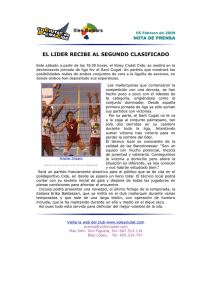la arquitectura de la escasez. las casas baratas de sant cugat
Anuncio
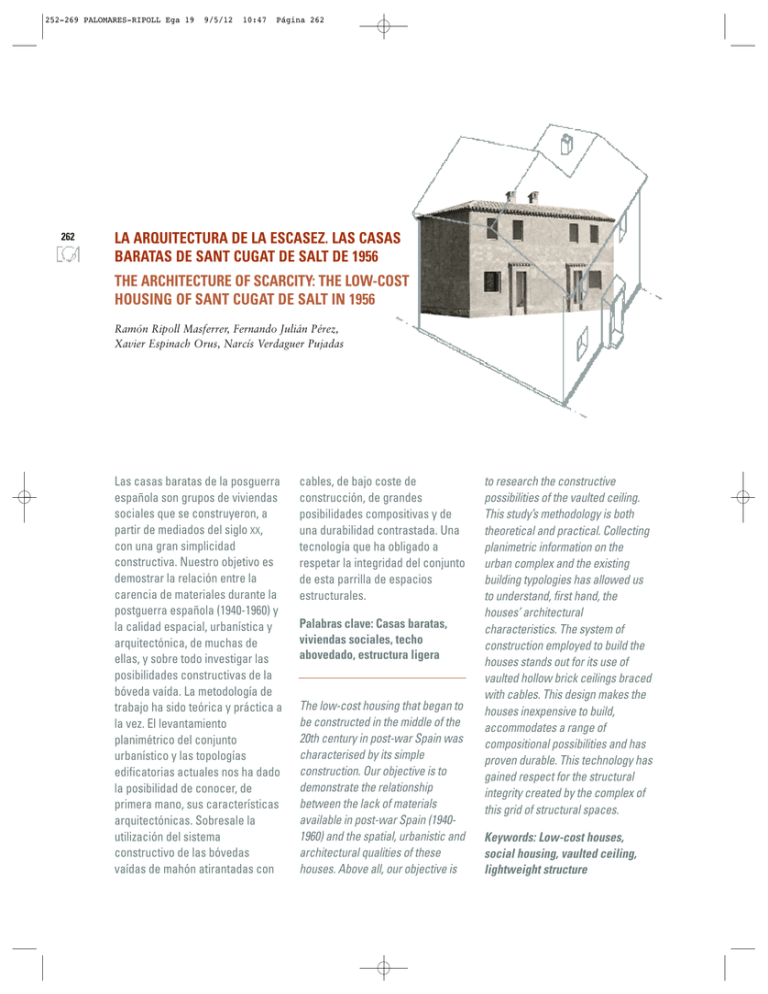
252-269 PALOMARES-RIPOLL Ega 19 262 9/5/12 10:47 Página 262 LA ARQUITECTURA DE LA ESCASEZ. LAS CASAS BARATAS DE SANT CUGAT DE SALT DE 1956 THE ARCHITECTURE OF SCARCITY: THE LOW-COST HOUSING OF SANT CUGAT DE SALT IN 1956 Ramón Ripoll Masferrer, Fernando Julián Pérez, Xavier Espinach Orus, Narcís Verdaguer Pujadas Las casas baratas de la posguerra española son grupos de viviendas sociales que se construyeron, a partir de mediados del siglo XX, con una gran simplicidad constructiva. Nuestro objetivo es demostrar la relación entre la carencia de materiales durante la postguerra española (1940-1960) y la calidad espacial, urbanística y arquitectónica, de muchas de ellas, y sobre todo investigar las posibilidades constructivas de la bóveda vaída. La metodología de trabajo ha sido teórica y práctica a la vez. El levantamiento planimétrico del conjunto urbanístico y las topologías edificatorias actuales nos ha dado la posibilidad de conocer, de primera mano, sus características arquitectónicas. Sobresale la utilización del sistema constructivo de las bóvedas vaídas de mahón atirantadas con cables, de bajo coste de construcción, de grandes posibilidades compositivas y de una durabilidad contrastada. Una tecnología que ha obligado a respetar la integridad del conjunto de esta parrilla de espacios estructurales. Palabras clave: Casas baratas, viviendas sociales, techo abovedado, estructura ligera The low-cost housing that began to be constructed in the middle of the 20th century in post-war Spain was characterised by its simple construction. Our objective is to demonstrate the relationship between the lack of materials available in post-war Spain (19401960) and the spatial, urbanistic and architectural qualities of these houses. Above all, our objective is to research the constructive possibilities of the vaulted ceiling. This study’s methodology is both theoretical and practical. Collecting planimetric information on the urban complex and the existing building typologies has allowed us to understand, first hand, the houses’ architectural characteristics. The system of construction employed to build the houses stands out for its use of vaulted hollow brick ceilings braced with cables. This design makes the houses inexpensive to build, accommodates a range of compositional possibilities and has proven durable. This technology has gained respect for the structural integrity created by the complex of this grid of structural spaces. Keywords: Low-cost houses, social housing, vaulted ceiling, lightweight structure 252-269 PALOMARES-RIPOLL Ega 19 9/5/12 10:47 Página 263 1 and 2. General view of the Sant Cugat neighbourhood. 3. Construction process (Historical Archive of Girona). Introducción Introduction En la historia de la arquitectura, la escasez económica y de materiales, no siempre corresponde a precariedad arquitectónica y urbanística. Las dificultades en la reconstrucción de la vivienda de la postguerra española, llevaron a una situación de ingenio administrativo y sobre todo tecnológico (Gómez 2006). El ejemplo que presentamos, las viviendas de San Cugat de Salt (1956) próximo a la ciudad de Girona en España, es un interesante caso de construcción de un barrio con un coste bajo. Hace una interesante reseña sobre el concepto de “vivienda humilde” y su relación con el diseño arquitectónico, así como sus imbricaciones con el sistema tecnológico y el coste de la obra (López 2003). Las autoridades de la época eran conscientes de las aportaciones y novedades tecnológicas llevadas a cabo: In the history of architecture, scarcity of money and materials has not always endangered architectural and urban innovation. The difficulty of reconstructing Spanish post-war housing led to an ingenious administrative and technological solution (Gómez 2006). The houses of San Cugat de Salt (1956) near the Spanish city of Girona represent an interesting case of a neighbourhood constructed at low cost. An useful outline has been made of the concept of “humble housing” and its relationship to architectural design, as well as its imbrications with the technological system and the cost of labour (López 2003). The authorities of the era were conscious of the technological advances and innovations that were occurring: “El patronato provincial de la vivienda… tiene como objetivo dar una vivienda decorosa y sana… hay que destacar la actuación llevada a término por los arquitectos Ignasi Bosch Reig, Josep Claret y Joaquim Masramon y otros…“ (Gobernador civil de Gerona, 1962). Remarcamos unos sistemas constructivos de gran simplicidad (bóvedas vaídas de mahón sobre tabiquillos cerámicos) e ingenio a la vez (atirantadas con cables de acero). Una tecnología que permite construir unas topologías arquitectónicas y una morfología urbanística de grandes posibilidades compositivas. Conocer en profundidad el funcionamiento de este tipo de construcciones, de peso reducido, resulta indispensable para cualquier intervención restauradora. El concepto de casas baratas fue definido en sucesivas leyes: 12 de junio de 1911, 10 de diciembre de 1921, 8 1 2 “The board of provincial housing…has the objective of providing decent and healthy housing…. Of note are the actions carried out by architects Ignasi Bosch Reig, Josep Claret and Joaquim Masramon, among others…” (Civil Governor of Gerona, 1962). 3 de julio de 1922, etc. Unas fechas ligeramente anteriores a las grandes creaciones del movimiento moderno (Gropius, le Corbusier, Mies Van der Rohe, etc.) pero que apuntaban en la misma dirección en los aspectos sociales (vivienda digna para todos), urbanísticos (racionalidad urbana), arquitectónicos (funcionalidad y sencillez), tecnológicos (nuevos sistemas constructivos) y económicos (reducción de costes). Restricciones del hierro y la bóveda vaída Las limitaciones impuestas en la utilización del hierro en el sector de la construcción durante la posguerra civil española fueron de gran importancia. Debido a la escasez y el correspon- We highlight a few systems of construction that are both simple (vaulting hollow brick ceilings over small ceramic partitions) and ingenious (bracing with steel cables). This technology accommodates both the construction of several architectural typologies and an urbanistic morphology with a wide range of compositional possibilities. An in-depth understanding of the functioning of this type of lightweight construction appears to be indispensable for making restorative interventions. The concept of low-cost housing was defined in successive laws, beginning with a law passed on 12 June 1911. Later laws include those made on 10 December 1921 and 8 July 1922. These dates slightly precede the major architectural works of Modernism (Gropius, le Corbusier, Mies Van der Rohe, etc.). However, the housing described in the laws shares the same social (dignified housing for all), urbanistic (urban rationality), architectural (functionality and simplicity), technological (new constructive systems) and economic (cost reduction) values articulated by the Modern movement. Restrictions on steel and the ribbed vault The limitations imposed on the construction sector’s use of steel in post-war Spain were of great importance. Because of the scarcity and the corresponding increase in the cost of steel and concrete, the Catalan vault was developed to resolve the structural building problems that resulted from the lack of materials. The constructive expresión gráfica arquitectónica 1 y 2. Vista general del barrio de Sant Cugat. 3. Proceso constructivo (Archivo histórico de Girona). 263 252-269 PALOMARES-RIPOLL Ega 19 9/5/12 10:47 Página 264 4. Proceso constructivo de la bóveda vaída (dibujo: R. Ripoll). 4. Construction process for a ribbed vault (drawing: R. Ripoll). 264 advantages of the vault were that when using flat hollow brick, walls, lintels, arches, sills and other structural features could be made. Importantly, this process lead to a simplified and rational system of building (Gulli 1994). The prohibition on using iron for construction affected the construction of walls and roofs, which typically measured 6 metres for a simple bay and 12 metres for a double bay. The law advised that the metallic frame for roofs of larger buildings be substituted with reinforced cement. The reduction of metallic elements was most necessary in housing construction. Alternative construction procedures (cement elements reinforced with minimal metallic frames, wooden roofs and, above all, brick vaults) were therefore implemented and adapted to the circumstances of each zone. The law advised that house roofs be reconstructed as brick vaults and required that the amount of iron used in balconies, railings, pipes, plates, bars and other elements be reduced. For official projects, the law allowed the use of 7 kg of iron per m3 of building space. The regulations that led to this law were approved on 22 July 1941. The cases of greatest interest to our study are the buildings of this era whose walls and ceilings were made exclusively of ceramic hollow brick. These buildings were characteristically covered with four-sided vaults, with a single thick layer covering the walls or with small partitions of hollow brick 1. Many architects have applied this technology in their designs, uniting the traditional local brick vault with the structural simplification of the fourpoint vault (which had been previously implemented in the buildings of several universities, including the University of Barcelona). The type of vault that was most used during the post-war years (especially in the regions of Girona) was the lowered four-centred arch that allowed for a significant amount of space to be covered with very low arch rises (25 to 45 cm) (Ripoll 2007). The versatility of this building technology did not go unnoticed by architects as important as Le Corbusier and others (Gulli 1994) 2. Urbanism The group of houses in Sant Cugat de Salt was approved by the Home Building Association (Obra Sindical del Hogar) in 1946. The project, which began in 1954 and was completed in 1956, was designed by architect Ignasi Bosch. The location selected for the project corresponded to the western side of the city and was situated next to Olot-Girona railroad line on a plot of land that was 4 diente incremento económico del hierro y el hormigón, la bóveda catalana se presentó como una técnica constructiva para resolver el problema estructural en la edificación. Las ventajas constructivas fueron que con mahón plano se podían realizar: paredes, dinteles, bóvedas, soleras… dando lugar a un sistema simplificado y racional de gran importancia (Gulli 1994). La prohibición del hierro en la construcción afectaba la realización de los muros y los techos (de luces normales de 6 metros en crujía sencilla y de 12 metros en crujía doble). La ley también aconsejaba que en las cubiertas de luces mayores se sustituyeran las armaduras metálicas por otras de cemento armado. En la realización de viviendas era precisa la máxima reducción de elementos metálicos sustituyéndolos por otros procedimientos constructivos (elementos de cemento armado con armaduras metálicas mínimas, techos de madera, y sobre todo con bóvedas de ladrillo) según las posibilidades de cada zona. Esta ley aconsejaba hacer los techos de las viviendas nuevamente con bóvedas de ladrillo. Obligaba a la reducción del hierro en balcones, barandillas, tuberías, chapas, rejas, etc. Admitía en los proyectos oficiales el uso del hierro hasta un peso determinado de 7 kg/m3 de edificación. El Reglamento que desplegó esta ley fue aprobado el 22 de julio de 1941. Los casos de mayor interés son los edificios de esta época que se realizaron con paredes y techos exclusivamente de mahón cerámico, caracterizados por estar cubiertos con bóvedas de cuatro puntos de una única lámina de grueso sobre paredes o tabiquillos de mahones 1. Muchos arquitectos aplicaron esta tecnología uniendo la tradición local (la bóveda de ladrillo) y la simplificación estructural de la bóveda de cuatro puntos (experimentada con anterioridad en algunas universidades como la de Barcelona). La bóveda más utilizada, durante los años de la posguerra (sobre todo en el caso de las comarcas gerundenses), fue la de cuatro puntos rebajada que permitía cubrir luces importantes con flechas de poca altura (de 25 a 45 cm) (Ripoll 2007). Las magníficas características de este tipo de tecnologías no pasaron desapercibidas a arquitectos de la importancia de Le Corbusier y otros (Gulli 1994) 2. El urbanismo El grupo de casas de Sant Cugat de Salt fue aprobado por la Obra Sindical del Hogar en 1946. El proyecto fue elaborado por el arquitecto Ignasi Bosch. Su construcción se realizó entre 1954 y 252-269 PALOMARES-RIPOLL Ega 19 9/5/12 10:47 Página 265 6. Planta general del barrio de Sant Cugat (dibujo: R. Ripoll). 5. General ordering of the Sant Cugat neighbourhood (drawing: R. Ripoll). 6. General design of the Sant Cugat neighbourhood (drawing: R. Ripoll). 5 6 1956. La ubicación escogida correspondió a la zona oeste de la población, junto al trazado del ferrocarril de Olot a Girona. Los terrenos de 26.244 m2. Las viviendas se organizaron en ocho manzanas de casas unifamiliares en hilera de dos plantas de altura. En el centro se hizo una novena manzana (plaza central) formada por cinco casas especiales en hilera con una altura de tres plantas. Las viviendas unifamiliares, facilitaban una ordenación de baja densidad. La disposición de edificios lineales con retranqueos, evitaba la simplicidad compositiva. La creación de una plaza central con cinco viviendas y locales comerciales en la planta baja, generó la idea de unidad espacial al conjunto. Es interesante remarcar que las casas baratas españo- las, realizadas durante la posguerra, tienen una cierta similitud de objetivos con muchas promociones de viviendas realizadas entre 20 y 30 años antes en Europa 3. Grandes espacios abiertos, calles anchas, edificios de baja altura, y zonas ajardinadas. La relación entre el espacio público y el privado se logró gracias a una proporción adecuada entre la plaza, el porche y las casas (en la zona comercial) y entre la calle, los jardines y las casas (en la zona residencial). Las calles son de 12m de anchura. Los solares se organizan longitudinalmente y tienen una superficie que oscila entre 165 y 185 m2. Los interiores de las manzanas se organizan a partir de pasajes de 3m., de anchura, que sirven de acceso a los jardines poste- expresión gráfica arquitectónica 5. Ordenación general del barrio de Sant Cugat (dibujo: R. Ripoll). 26,244 m2. The houses were organised in eight blocks of single-family, two-story houses that were arranged in a row. In the centre, a ninth block (plaza central) was made, which consisted of a row of five special three-story houses. The single-family housing facilitated a low-density population distribution. The layout of the linear buildings, which were set back from the road, created compositional interest. The creation of a central plaza of five houses with commercial establishments on the ground floor contributed to the spatial unity of the complex. It is notable that the low-cost houses of Spain that were built during the post-war period share similar objectives with much of the housing built 20 to 30 years earlier in Europe 3. Bosch’s design included large open spaces, wide streets, low buildings and gardened areas. The relationship between public and private space was made possible by maintaining harmonious proportions among the plaza, the porch and the houses in the commercial zone and among the street, gardens and the houses in the residential area. The streets were 12 m wide. The plots were organised longitudinally and varied between 165 m2 and 185 m2. The interiors of the blocks were organised around passages 3 m wide, which served as an access to the rear gardens. The open central plaza acted as an urban nucleus that organised the orthogonal plot of the streets (Bosch 1956). The building rows were designed to prevent neighbouring houses from facing each other when possible. For this reason, the façades of many of the houses are hidden from the view of the neighbours. The architecture The design of the house varied according to whether it had 2, 3 or 4 bedrooms. The accessibility of the entrance also introduced a typological variant in the houses set back from the street corners. The majority of the houses followed a standardised model to promote cost reduction. Each house had a stair entryway (4.5 m2), a dining room (9 m2), a kitchen (4 m2) and a complementary room (8 m2) on the ground floor. The 2, 3 or 4 bedrooms of the upper floor varied in dimension between 5 and 8 m2. A bathroom below the stairs and a small area for laundry in the rear patio completed the house. These modest houses are small when compared with the size of the backyard, which consisted of a garden that, according to inhabitants, greatly influenced their decision to purchase the home. Many families wanted to expand the house according to future needs by adding a garage, shed, study or other needed rooms. One policy approved 265 252-269 PALOMARES-RIPOLL Ega 19 9/5/12 10:47 Página 266 7. Distribución casa de 2 plantas del barrio de Sant Cugat (dibujo: R. Ripoll). 7. Arrangement of a two-story house of the Sant Cugat neighbourhood (drawing: R. Ripoll). 266 by the Home Building Association (Obra Sindical del Hogar) allowed the owners to put up fences for the garden and to construct secondary buildings. Another important aspect of the houses is the open interior arch layout used to connect spaces such as the entryway and the dining room, or even the dining room and the kitchen. The bathroom is located on the ground floor, below the stairs. The laundry room, which was initially in one corner of the backyard wall, required one to exit toward the rear of the house for access. The facades were designed to create the illusion of greater size. The architectural elements that were used, including eaves, balconies, fireplaces and front porches, mimicked the popular traditional architectural language with a certain air of academic composition. The interior of the houses is formed by the sum of the spaces or rooms. The rooms that are covered by vaults create a sense of unity among the visually autonomous elements of the house. We can therefore understand one of these singlefamily houses as the sum of these vault-covered rooms. This idea is also enhanced by the orientation of the vaulted ceiling, which always revolves around a centre, stabilising the interior space and simultaneously providing a feeling of rest and movement. The result is an atmosphere of balanced tension. The technology The vault design required a lightweight construction material. Hollow bricks 4x14x28 cm and 7x14x28 cm proved ideal. These bricks were easy to organise and build with, light in weight and, above all, inexpensive. A single layer of 4x14x28 cm hollow brick was used to cover ribbed vaults. This technique transferred the stress to the corners of the rooms and lightened the load on the remaining intermediate panels of the end partitions. The weight was further decreased by using flat pavers in the floors and sloped pavers in the roof. These pavers were also constructed using 4x14x28 cm hollow brick, and were always built over vertical partitions. The housing regulations in 1941 established an overload limit of 150 kg/m2. The combined weight of the vault and the horizontal paver was 80 kg/m2. The weight of the mosaico hidráulico tile was 30 kg/m2 (Cabrera, Sala and Jordi 2005). The use of steel was limited to the interior cables of the concrete bands, which were placed 5 cm above the start of the rise of the vaults. These vaults were shaped by a 12 to 16 7 riores. La disposición de la plaza central abierta en dirección al centro del núcleo urbano, organiza la trama ortogonal de las calles (Bosch 1956). Las hileras de edificios evitan normalmente el encuentro frontal con las casas vecinas, por esto, en muchas calles las visuales de las fachadas principales rehúyen el contacto vecinal frontal. La arquitectura Encontramos diferentes tipos de casas según tengan 2, 3, y 4 habitaciones. La disposición de la entrada introduce a la vez otra variante tipológica en las casas retranqueadas de las esquinas. La mayoría siguen un modelo estandarizado (reducción de costes). Cada vivienda estaba formada por una entrada-escalera (4,5 m2), un comedor (9 m2), una cocina (4 m2) y una habitación complementaria (8 m2) en la planta baja. Las 2, 3 y 4 habitaciones de la planta superior podían tener diferen- tes dimensiones (entre 5 y 8 m2). Un cuarto de baño debajo de la escalera y un pequeño lavadero en el patio posterior completaban la vivienda. Estas casas mínimas contrastaban con la amplitud del patio posterior, un jardín que, según la opinión de los vecinos, fue decisivo en la compra. Muchas familias tenían la idea que ampliarían la casa según las necesidades futuras (garaje, almacén, estudio, etc.). Un aspecto contemplado por la Obra Sindical del Hogar, permitía que los mismos propietarios realizaran las vallas del jardín y construyeran edificaciones secundarías. Otro aspecto es la disposición de arcos interiores abiertos, que unen dos espacios como son la entrada y el comedor, o bien el comedor y la cocina. El cuarto de baño queda situado en la planta baja y debajo de la escalera. El lavadero que inicialmente estaba en un rincón de la pared del patio posterior, 252-269 PALOMARES-RIPOLL Ega 19 9/5/12 10:47 Página 267 8. Arrangement of a three-story house of the Sant Cugat neighbourhood (drawing: R. Ripoll). 8 obligaba a salir al exterior para poder acceder a él. Las fachadas se diseñaron para dar una imagen de mayor tamaño. Los elementos arquitectónicos empleados (aleros, balcones, chimeneas, porche de entrada…) siguen un lenguaje popular tradicional con un cierto aire de composición académica. El interior de las viviendas está formado por la suma de espacios o crujías. Habitaciones cubiertas con bóvedas que potencian la idea de unidad de cada una de las piezas visualmente autónomas. De esta manera podemos entender una de estas casas unifamiliares como la suma (adición) de estas crujías cubiertas de bóvedas. Una idea que queda realzada por el sentido espacial de la misma bóveda vaída que gira siempre alrededor de un centro, estabilizando el espacio interior y dando la sensación de reposo y movimiento a la vez. El resultado es una atmósfera de tensión equilibrada. La tecnología La tecnología ligera tenía como material básico de construcción los mahones de 4x14x28 cm. y de 7x14x28 cm. De fácil organización, rápida ejecución, reducido peso y sobre todo de bajo coste, permitía el cubrimiento con bóvedas vaídas (de una lámina de ladrillo agujereado de 4x14x28 cm.) trasladando los esfuerzos a las esquinas de las crujías, aligerando a la vez el resto de los paños intermedios de los tabiques de cierre. La disminución del peso continuaba mediante soleras planas (en los pisos) y soleras inclinadas (en la cubierta) de mahones de 4x14x28 cm. realizados siempre sobre tabiques verticales. Las normas para viviendas de 1941, fijan una sobrecarga de uso de 150Kg/m2. El peso propio de la bóveda y la solera horizontal era de 80kg/m2. El del mosaico hidráulico era de 30 kg/m2 (Cabrera, Sala y Jordi mm iron rod, whose diameter varied according to the dimensions of the vault. With respect to the structural calculations, Bosch understood that if the radial forces were supported at the corners, the intermediate spans would not have to bear as much of the load. If the corners remained stable, the vaults could be constructed over consecutive columns or walls formed by thin partitions. He regarded a ribbed vault as comprising four low arches, treating each arch as a square or rectangle of a particular width that was supported in the corners. This structure could be expanded using successive internal strips to achieve the same results. In this way, the central part of the vault could be left open without compromising the building’s structural integrity. This design allowed the calculations for the ribbed vault to be simplified using approximate results. The strips described above were designed using the formula M = p.l2 / 8 = Hr => H = p.l2 / 8.r. = p.12 / 8 = Hr (r = rise of the arch in the axis of the bar; p = q.b (q = unitary load of the vault; i b = width of the strip)). The horizontal force H, which is applied in the corner and toward one of the sides of the vault, combines with the horizontal force being applied in the opposite direction and from the other side of the vault. The resulting horizontal force follows the direction of the diagonal of the floor of the vault. This horizontal component is offset by the cable located within the concrete ring beam, a vertical element of the vault (Gelada 1977). The vertical component is the result of the weight of the vault and its use load, which is transmitted through the vertical corners, which support the vault. The vertical force should not exceed either the resistance of the thin hollow brick wall or the other fragile elements of the structure. Bosch’s design is essentially static and therefore simple. This technique works with structural spaces smaller than 4 m in length because it avoids more complex, difficult and costly dynamic designs. Conclusions Our study confirms the possibility of designing wellconceived architecture, even when faced with a scarcity of materials. In this case, the hollow brick vaults braced with cables have, over time, proven to be both effective and durable. This support technology deserves respect for the structural integrity it lends to the entire grid of vaults, which are counterbalanced with the grids both within the house and with those in the neighbouring building. The sound construction of the edifices built using this system has prevented the demolition or structural alteration of many of these houses during expresión gráfica arquitectónica 8. Distribución casa de 3 plantas del barrio de Sant Cugat (dibujo: R. Ripoll). 267 252-269 PALOMARES-RIPOLL Ega 19 9/5/12 10:47 Página 268 9. Descomposición en franjas estructurales de la bóveda vaída (dibujo: R. Ripoll). 10. Unión constructiva entre la bóveda vaída y la solera (dibujo: R. Ripoll). 11. Proceso constructivo de la bóveda vaída del barrio de Sant Cugat (dibujo: R. Ripoll). 268 9 10 11 2005). El uso del acero se reduce a los tirantes interiores de los zunchos de hormigón, colocados 5 cm. por encima del arranque de las bóvedas, formados por una varilla de hierro de 12 a 16 mm, de diámetro según las dimensiones de cada bóveda. Respecto al cálculo estructural Bosch conocía los esfuerzos radiales que se apoyaban en los ángulos, liberando los vanos intermedios, pudiendo construir sus bóvedas sobre pilares o muros corridos formados por tabiques, siempre que las esquinas se mantuviesen estables. Consideraba que una bóveda vaída se comportaba como cuatro arcos rebajados dibujando el perímetro de un cuadrado o un rectángulo de una anchura determinada que se apoyaba en las esquinas. Un comportamiento que se mantenía si se ampliaba sucesivamente con franjas sucesivas internas. De esta manera se podría dejar abierta la parte central de la bóveda sin que se resintiera estructuralmente. Este planteamiento le permitió simplificar el cálculo de las bóvedas vaídas con resultados aproximados. Las franjas descritas anteriormente les aplicaba la formula M = p.l 2 /8 = Hf => H = p.l2 / 8.f. (f = flecha del arco en el eje de la franja, p = q.b (q = carga unitaria de la bóveda, i b = anchura de la franja)). El esfuerzo horizontal H que nos da en la esquina en la dirección de uno de los lados de la bóveda, se combina con el esfuerzo horizontal resultante de la otra dirección del otro lado de la bóveda. El esfuerzo horizontal resultante sigue la dirección de la diagonal de la planta de la bóveda. Esta componente horizontal es contrarrestada por el cable situado dentro del zuncho de hormigón armado situado en el arranque de la bóveda (Gelada 1977). El componente 252-269 PALOMARES-RIPOLL Ega 19 9/5/12 10:47 Página 269 expresión gráfica arquitectónica 9. Separation of the structural strips of the ribbed vault (drawing: R. Ripoll). 10. Joint between the ribbed vault and the pavers (drawing: R. Ripoll). 11. Construction process for the ribbed vault typical of the Sant Cugat neighbourhood (drawing: R. Ripoll). vertical es el resultado del peso de la bóveda y de la carga de uso de la misma, que se transmite por las esquinas verticales en donde se apoya la bóveda. El esfuerzo vertical no debe sobrepasar tanto la resistencia del tabique de mahón como sus características de fragilidad. Este planteamiento aplicado por Bosch es eminentemente estático y por tanto de gran simplicidad. Un enfoque que funcionaba en luces estructurales inferiores a 4 m de longitud por evadir planteamientos dinámicos más complejos, difíciles y caros de solucionar. Conclusiones Como conclusión podemos afirmar la posibilidad de hacer una arquitectura correcta a partir de la escasez de materiales. En este caso las bóvedas de mahón atirantadas con cables, se han mostrado con el paso del tiempo, muy eficaces y duraderas. Una tecnología de la solidaridad que ha obligado a respetar la integridad del conjunto de esta parrilla de bóvedas contrarrestadas unas con las otras y las de una casa con las del edificio vecino. Un sistema que ha evitado el derribo o mutación estructural, de muchas de estas casas durante estos 55 años de vida del barrio de Sant Cugat, por este mismo principio de solidaridad constructiva (Ripoll 2006). Unas topologías que hasta hace poco han sido consideradas como una arquitectura menor. Últimamente se está reivindicando, cada vez más, la modernidad de su actitud de gran sinceridad y realismo en la que ha sabido aunar tradición y modernidad. Unos planteamientos que no distan de algunos de los conceptos fundamentales de la modernidad arquitectónica más ortodoxa de la primera mitad del siglo XX. Unas características en las que los mismos usuarios, se han convertido en los mejores defensores de una manera de vivir llena de coherencia, sencillez y funcionalidad. NOTAS 1 / Permitía una disminución del peso total del edificio y la correspondiente memorización de los empujes de las bóvedas de cuatro puntos sobre las esquinas de las crujías. Permitía a la vez el alivio de los gruesos de las paredes (hasta tabiques de mahón de 4 o 7 cm de grueso) y la reducción de las dimensiones de los cimientos. 2 / Las obras más conocidas de Le Corbusier en donde aplicó la bóveda de ladrillo plano reforzada con hormigón son: el conjunto de Roq y Roc (1949) en Cap Martin de la Costa Azul; en la es la Casa Jaoul (1952) en Neuilly-sur-Seine; la residencia de Sra. Manorama Sarabhai (1955) en Almendabad (India), etc. Un sistema mixto utilizado en el periodo de los antiguos romanos que fue el antecedente de la bóveda catalana. 3 / Problemáticas parecidas pero con resultados urbanos, arquitectónicos y constructivos diferentes. Viviendas sociales alemanas (Siedlungen, 1920) en la que se crearon barrios de una gran vitalidad social, y considerable calidad arquitectónica. Se realizaron en una situación económica difícil que obligó a investigar nuevos sistemas de gestión residencial. Bruno Taüt plantea la teoría de la organización de la vivienda social en Alemania en la década de los años veinte. Referencias – BOSCH, I., 1956. Planos del Archivo del Colegio de Arquitectos de Cataluña. Demarcación de Girona. – CABRERA, A., SALA, M. y JORDI, C., 2005. Les voltes de quatre punts. Estudi constructiu i estructural de les cases barates. Girona: Colegio de aparejadores y arquitectos técnicos de Girona, p. 89. – GELADA, J. M., 1977. La volta de Quatre punts. Revista La Punxa, nº. 25. Colegio Oficial de aparejadores y Arquitectos Técnicos de Girona, pp.44-49. – GOBERNADOR civil de Gerona, 1962. Carta del Gobernador dirigida a los Alcaldes de la provincia de Gerona. Fuentes del Patronato provincial de la Vivienda. Archivo Provincial de Girona. – GÓMEZ, M. L., 2006. La intención administrativa en la vivienda en España. 1938-2005. Madrid: Editorial Montecorvo, pp.8-20. – GULLI, R., 1994. La memoria delle tecniche. Le Corbusier e la volta catalana. Ancona: Clua Edizioni, p.28/p.32. – LÓPEZ, J., 2003. Vivienda social y Falange. Ideario y construcción en la década de los 40. Scripta. Revista de geografía y ciencias sociales. UB. nº.146, p. 24. – RIPOLL, R., 2007. La bóveda vaída y las casa del barrio de Sant Cugat de Salt (Girona, 1956). Burgos: Actas de V Congreso Nacional de Historia de la Construcción, pp.755-762. – RIPOLL, R., 2006. 50 anys del barri de Sant Cugat. Les Cases barates de Salt. Girona: Diputación de Girona y Ayuntamiento de Salt, pp.20-29. the Sant Cugat neighbourhood’s 55-year existence (Ripoll 2006). Some of the typologies observed in these houses, which until recently had been considered lesser architecture, have been increasingly vindicated for their Modern commitment to simplicity and realism and for their combination of tradition and modernity. This approach is in harmony with the fundamental concepts espoused by the orthodox Modern architecture of the first half of the 20th century. The users themselves can testify that the characteristics of these spaces contribute to a life of coherence, simplicity and functionality. NOTES 1 / This decreased the total weight of the building and allowed for the corresponding placement of the four-point vault thrusts over the corners of the rooms. In addition, it reduced the thickness of the hollow brick walls, which measured between 4 and 7 cm thick. It likewise reduced the dimensions of the foundation. 2 / The most well-known works of Le Corbusier that employ a flat brick vault reinforced with concrete include the Roq et Rob complex (1949) in Cap Martin, Costa Azul; Casa Jaoul (1952) in Neuilly-sur-Seine; and the Villa de Madame Manorama Sarabhai (1955) in Ahmedabad, India. A mixed system used by the ancient Romans preceded the Catalan vault. 3 / Similar problems have produced different urban, architectural and construction results. For instance, German social housing (Siedlungen, 1920) created neighbourhoods with considerable social vitality and architectural quality. These neighbourhoods were constructed during an economic slump, which led planners to research of new residential management systems. Bruno Taüt proposed the theory of social housing in Germany in the 1920s. References – BOSCH, I., 1956. Archive Designs of the College of Architecture of Catalonia. Delineation of Girona. – CABRERA, A., SALA, M. and JORDI, C., 2005. Four-point vaults. Structure and construction study of low-cost houses Girona: The college of technical surveyors and architects of Girona, p. 89. – GELADA, J. M., 1977. The four-point vault. La Punxa Journal, no. 25. The Official College of Technical Surveyors and Architects of Girona, pp. 44-49. – CIVIL GOVERNOR of Girona, 1962. A letter from the Governor directed to the Mayors of the province of Girona. Sources of the Provincial Housing Board. Provincial Archives of Girona. – GÓMEZ, M. L., 2006. Administrative intention in housing in Spain. 1938-2005. Madrid: Montecorvo Editorial, pp.8-20. – GULLI, R., 1994. The memory of technique. Le Corbusier and the Catalan vault. Ancona: Clua Edizioni, p.28/p.32. – LÓPEZ, J., 2003. Social housing and the Falange. Ideology and construction in the early 40’s. Scripta. Journal of geography and social sciences. UB. No. 146, p. 24. – RIPOLL, R., 2007. The vaulted ceilings of the houses of the Sant Cugat de Salt neighbourhood (Girona, 1956). Burgos: Proceedings of the 5th National Congress of the History of Construction, pp.755-762. – RIPOLL, R., 2006. 50 years of the Sant Cugat neighbourhood. The low-cost houses of Salt. The Deputation of Girona and the City Council of Salt, pp. 20-29. 269
